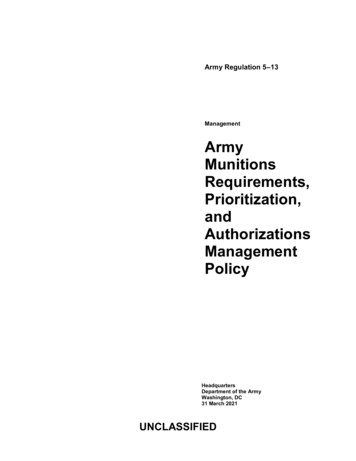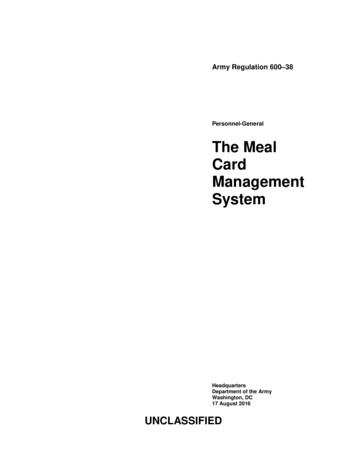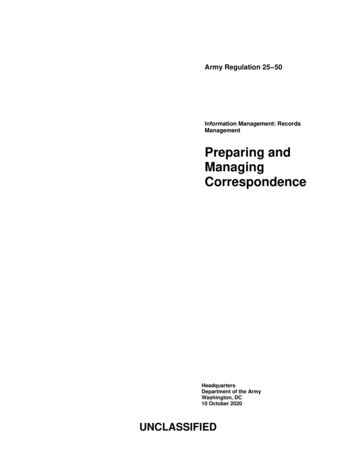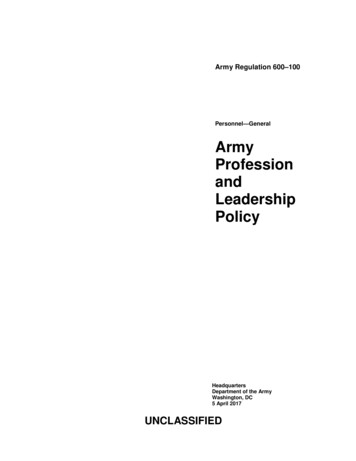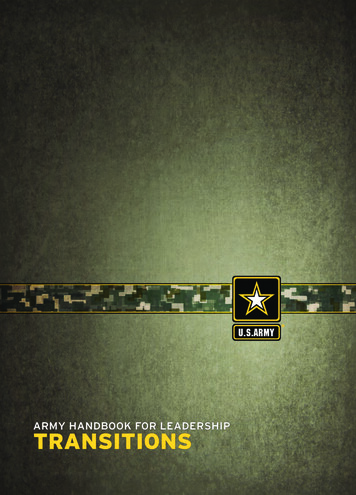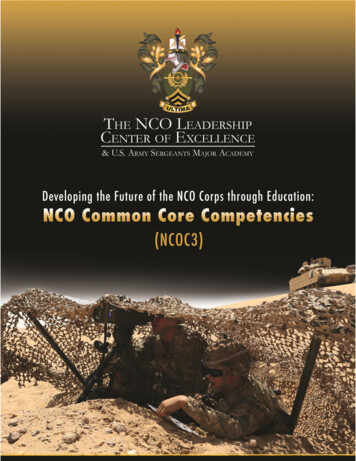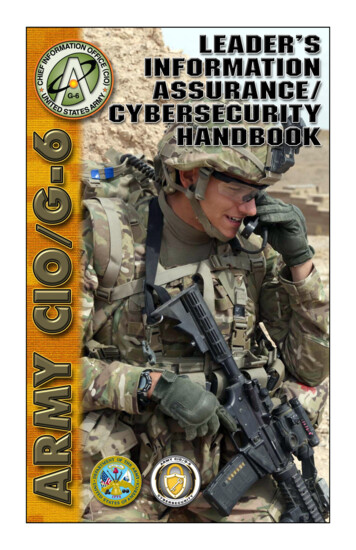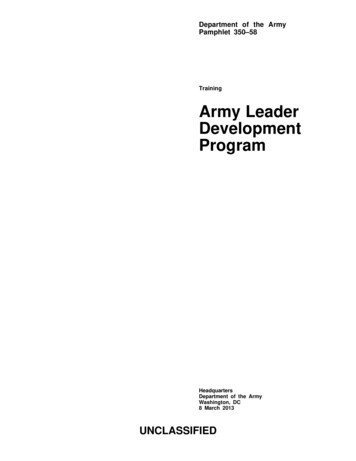
Transcription
Department of the ArmyPamphlet 350–58TrainingArmy LeaderDevelopmentProgramHeadquartersDepartment of the ArmyWashington, DC8 March 2013UNCLASSIFIED
SUMMARY of CHANGEDA PAM 350–58Army Leader Development ProgramThis major revision, dated 8 March 2013-oChanges the title from Leader Development for America’s Army to Army LeaderDevelopment Program (cover).oIntroduces detailed processes for the Army Leader Development Program forArmywide implementation (chap 2)oOutlines the Army Leader Development Program standard forums (throughout).
*Department of the ArmyPamphlet 350–58HeadquartersDepartment of the ArmyWashington, DC8 March 2013TrainingArmy Leader Development ProgramComponent military Soldiers and Department of the Army Civilians as stated inAR 350–1.Applicability. This pamphlet applies tothe Active Component, the Army NationalGuard/Army National Guard of the UnitedStates, and U.S. Army Reserve, unlessotherwise stated.History. This publication is a majorrevision.Summary. This pamphlet describesprocesses and methodology used to manage the Army Leader Development Program for Active Component and ReserveContentsProponent and exception authority.The Deputy Chief of Staff, G–3/5/7 is theproponent of this pamphlet. The proponent has the authority to approve exceptions or waivers to this pamphlet that areconsistent with controlling law and regulations. The proponent may delegate thisapproval authority, in writing, to a division chief within the proponent agency orits direct reporting unit or field operatingagency, in the grade of colonel or thecivilian equivalent. Activities may requesta waiver to this pamphlet by providingjustification that includes a full analysis ofthe expected benefits and must includeformal review by the activity’s seniorlegal officer. All waiver requests will beendorsed by the requesting activity’s commander or senior leader and forwardedthrough their higher headquarters to thepolicy proponent. Refer to AR 25–30 forspecific guidance.Suggested improvements. Users areinvited to send comments and suggestedimprovements on DA Form 2028 (Recommended Changes to Publications andBlank Forms) directly to Deputy Chief ofStaff, G–3/5/7 (DAMO–TR), Washington,DC 20310–0450.Distribution. This publication is available in electronic media only and is intended for command levels C and D forthe Active Component, the Army NationalGuard/Army National Guard of the UnitedStates, and U.S. Army Reserve.(Listed by paragraph and page number)Chapter 1Introduction, page 1Purpose 1–1, page 1References 1–2, page 1Explanations of abbreviations and terms 1–3, page 1Army Leader Development Program defined 1–4, page 1Current perspective 1–5, page 1Leader development overview 1–6, page 1Chapter 2Framework, page 2Army Leader Development Program framework 2–1, page 2Army Leader Development Process 2–2, page 2Army Leader Development Program forums 2–3, page 4Framework, duties, and functions 2–4, page 5*This pamphlet supersedes DA Pam 350–58, dated 13 October 1994.DA PAM 350–58 8 March 2013UNCLASSIFIEDi
Contents—ContinuedChapter 3Initiative Process, page 5Army Leader Development Program initiative process and life cycle 3–1, page 5Initiative development 3–2, page 5Initiative process 3–3, page 6Monitor and assess progress 3–4, page 8Initiative Removal , page 8Chapter 4Army Leader Development Program Initiative Prioritization, page 9Army Leader Development Program Priority List Development 4–1, page 9Resourcing 4–2, page 11AppendixesA.References, page 12B.Proposed Initiative Submission Memorandum, page 12C.Assessment Support Document, page 13D.Cost Benefit Analysis Guidelines, page 15E.Policy Implications Worksheet, page 15F.Army Leader Development Plan Initiative Milestone Plan, page 16G.Army Leader Development Program Initiative Removal Memorandum, page 17H.Army Leader Development Program Initiative Measures of Success, page 19I.Army Leader Development Program Quad Chart, page 19J.Army Leader Development Program Address List, page 20Table ListTable C–1: Funding status, page 15Figure reFigureFigureFigureFigureFigureFigure1–1: Army’s Leader Development Model, page 22–1: Army Leader Development Process Model, page 32–2: Army Leader Development Execution Model, page 43–1: Army Leader Development Program Initiative Process, page 63–2: Army Leader Development Program Initiative Numbering Methodology, page 73–3: ALDP Initiative Removal Process, page 94–1: Army Leader Development Program Initiatives Priorities List Development, page 10B–1: Sample Memorandum, page 13C–1: Sample Document, page 14E–1: Policy Implications Worksheet, page 16F–1: Army Leader Development Program Milestone Plan, page 17G–1: Sample of a Army Removal Memorandum, page 18H–1: ALDP Measures of Success, page 19I–1: ALDP Removal Quad Chart, page 20GlossaryiiDA PAM 350–58 8 March 2013
Chapter 1Introduction1–1. PurposeThis pamphlet outlines the processes for the Army Leader Development Program (ALDP). It guides those who areresponsible for developing officers, warrant officers, noncommissioned officers, and civilian leaders of the ActiveComponent, the Army National Guard, and the U.S. Army Reserve. It describes methodology and processes used tomanage the ALDP which supports the three pillars of leader development: education, training, and experience.1–2. ReferencesRequired and related publications and prescribed and referenced forms are listed in appendix A.1–3. Explanations of abbreviations and termsAbbreviations and special terms used in this pamphlet are explained in the glossary.1–4. Army Leader Development Program definedThe ALDP is the Army’s program for managing Headquarters, Department of the Army (HQDA) approved leaderdevelopment initiatives. The ALDP is the sole management process for program execution, approval, incorporation ofnew initiatives, and recommendations for prioritization of resources.1–5. Current perspectiveToday’s complex operational environment poses a wide range of possible threats under chaotic conditions. Thiscomplex environment requires leaders that can perform across the range of military operations, guided by the doctrineof mission command and operating under the ideals of the Army Profession. Accordingly, it is critical that the Armyfocus on the strategic end of developing military and civilian leaders to meet the challenges of the 21st Century. TheALDP supports this objective.1–6. Leader development overviewLeader development is a deliberate, continuous, sequential, and progressive process grounded in the Army values. Itgrows Soldiers and Civilians into competent and confident leaders capable of directing teams and organizations toexecute decisive action. Leader development is achieved through the lifelong synthesis of the knowledge, skills, andabilities gained through education, training, and experience. The ALDP generates a range of initiatives to produceleaders with the proper education, training, and experience to lead our Army in the future. Leader developmentfoundations and principals are described in AR 350–1 and ADP 7–0. The Army’s Leader Development Model isdepicted below.DA PAM 350–58 8 March 20131
Figure 1–1. Army’s Leader Development ModelChapter 2Framework2–1. Army Leader Development Program frameworkThis chapter outlines the framework used to execute the ALDP.2–2. Army Leader Development ProcessMultiple stakeholders are involved in shaping strategic decisions that impact Army leader development. The ArmyLeader Development Process Model communicates fundamental leader development authorities, roles, stakeholderorganizations, and forums. Proposed policy changes flow top to bottom and bottom to top, while synchronization andintegration occur between each of the organizations and forums. Figures 2–1 and 2–2 are simple depictions of theboundaries and interface between key stakeholder organizations. It is essential to understand—a. The Secretary of the Army has statutory authority to administer Title 10 (10 USC) functions on behalf of theArmy and vests authority in the Assistant Secretary of the Army (Manpower and Reserve Affairs) (ASA (M&RA)) toexecute their responsibilities.b. The Chief of Staff, Army (CSA) leads and shapes leader development for the Army.c. The ASA (M&RA) is responsible for supervising the development of all policies, plans, and programs pertainingto readiness resourcing, training, and professional and leader education and development.d. The Deputy Chief of Staff, G–3/5/7 (DCS, G–3/5/7) is the Army staff (ARSTAF) proponent for Army trainingand leader development policy and resourcing.e. The Commanding General, U.S. Army Training and Doctrine Command (CG, TRADOC) is the senior responsibleofficial (SRO) for Army leader development.f. The Army Leader Development Process Model depicts the various roles and responsibilities for leader development by forum (see fig 2–1). The matrix represents the four levels of authority within the Army Leader DevelopmentProcess:2DA PAM 350–58 8 March 2013
Figure 2–1. Army Leader Development Process Model(1) The ASA (M&RA) exercises statutory authority through its lead of Army Campaign Plan objectives to superviseand set the strategic direction for leader development and provides synchronization through the Human CapitalExecutive Board.(2) The CSA exercises authority to provide guidance through the annual Army Training and Leader DevelopmentConference. The CSA approves and directs Army Leader Development efforts based on input from the SRO on leaderdevelopment initiatives, programs, policies, and priorities. AR 350–1 provides details on the conference.(3) ARSTAF.(a) Deputy Chief of Staff, G–1 is a leader development stakeholder with ARSTAF policy and regulatory authorityfor leadership and personnel policies that support leader development.(b) The DCS, G–3/5/7 is the ARSTAF proponent for leader development policy and resourcing.(4) CG ,TRADOC leads, manages, and shapes leader development for the Army. On behalf of the CSA, the CG,TRADOC serves as the SRO for Army leader development and provides the CSA recommendations for decisions onleader development policies, programs, and priorities. As the SRO for leader development, CG, TRADOC is vestedwith authority to shape and lead Army leader development for all cohorts and provides visibility and guidance to shapeArmy leader development efforts. CG, TRADOC and the Army Leader Development Forum (ALDF) represent thefocal point of the Army Leader Development Process, integration, and execution. The ALDF is where leader development initiatives are introduced, developed, tracked, and approved to compete for funding, implementation, andintegration across the Army.DA PAM 350–58 8 March 20133
Figure 2–2. Army Leader Development Execution Model2–3. Army Leader Development Program forumsFour standard forums operate to manage and oversee execution of the ALDP. From action-officer level to culminatingforum they are as follows:a. Action Officer and/or Lead Agent Forum. The Center for Army Leadership (CAL), Army Leader DevelopmentDivision hosts the action officer and/or lead agent forum to monitor progress in achieving milestones and reporting onthe funding status, and other developments affecting initiative execution. Unresolved issues at the action officer levelmay be brought to the Army Leader Development Council of Colonels and/or recommended for elevation to the ArmyLeader Development Forum. Action officer and/or lead agent Forum participants include TRADOC staff, initiative leadagents, HQDA staff (Secretariat and ARSTAF), and action officers representing Army commands (ACOM), Armyservice component commands (ASCC), direct reporting units (DRU), the Army National Guard (ARNG), and the U.S.Army Reserve Command (USARC).b. Council of Colonels The Army Leader Development CoC is conducted prior to an ALDF. CoC participantsprovide recommendations to the ALDF on current leader development issues and initiatives and aid in maintaining acontinuous leader development dialog. Representatives typically track working group progress and recommend actionable items that must go to CG, TRADOC for decision. CoC voting members include representatives from: ACOM,ASCC, DRU, Field Operating Agencies, HQDA staff (Secretariat and ARSTAF), Director, Army National Guard(DARNG), Chief of Army Reserve (CAR), and other organizations, as appropriate.c. The Army Leader Development Forum, (formerly the Prepare the Army Forum). The Army Leader DevelopmentForum is an Army-level forum governed by TRADOC. The ALDF critically examines leader development initiativesand programs, discusses issues, and advises CG, TRADOC and/or SRO.(1) CG, TRADOC chairs the ALDF. Authority for decisions at the ALDF rest with CG, TRADOC and/or SRO.(2) ALDF primary membership includes general officers and/or equivalent from each ACOM, ASCC, DRU, ARNG,USAR, U.S. Army Human Resources Command, as well as HQDA (Secretariat and ARSTAF), and other organizationswhen appropriate. The SRO may invite other principals to attend based upon issues being presented.(3) The ALDF meets four times annually to synchronize issue development.(4) The SRO-approved recommendations from the ALDF are forwarded to Army Senior Leaders, as appropriated. Chief of Staff, Army Review. Following an ALDF, the CG, TRADOC routinely conducts a leader development4DA PAM 350–58 8 March 2013
review and update with the CSA. Attendance typically includes: CG, TRADOC; CG, Combined Army Center (CAC);DCS, G–1; and DCS, G–3/5/7. The CSA review provides a forum to:(1) Approve and/or disapprove leader development initiatives(2) Approve policy decisions.(3) Make decisions on adjustments to the ALDP.(4) Approve the ALDP Initiatives Priorities List (APL).(5) Provide direction to CG, TRADOC as SRO.2–4. Framework, duties, and functionsa. CG, TRADOC—(1) Leads, manages, and executes Army leader development.(2) Synchronizes ALDP initiatives and recommends policy revisions to HQDA.(3) Approves limits on the incubation, pilot, and/or test period, or life cycle of an initiative based on an evaluationfor redundancy, return on investment, and suitability for continuation in the ALDP.(4) Recommends prioritization of leader development initiatives. Develops and forwards priorities list recommendations to the CSA for approval.(5) Approves or disapproves initiatives for inclusion or removal from the ALDP.b. Army Leader Development Forum members—(1) Submit proposed leader development initiatives to CG, TRADOC for assessment for inclusion into the ALDP.(2) Request CG, TRADOC approval for modifications to initiatives or lead agent reassignments.(3) Forward all correspondence through the Army Leader Development Division.c. Organizations or lead agents—(1) Identify action officers for assigned initiatives and update Army Leader Development Division when actionofficers are reassigned or replaced.(2) Attend action officer and executive-level forums, teleconferences, and in progress reviews.(3) For assigned or submitted initiatives—(a) Forward all correspondence through the Army Leader Development Division.(b) Develop and maintain an assessment support document and submit quarterly (see app C).(c) Develop and submit a cost-benefit analysis, if required (see app D).(d) Develop and maintain an updated resource management worksheet or TRADOC-approved alternative format.(e) Develop and maintain a policy implications worksheet (see app E).(f) Develop and maintain a detailed milestone plan leading to implementation (see app F).(g) Provide status, updates on return on investment, status of funding requirements, and suitability for initiativecontinuation.(h) Coordinate efforts to achieve objectives identified in the Assessment Support Document.(i) Perform staff coordination necessary to implement approved initiatives.(j) Ensure organizations submit concept plans to DCS, G–3/5/7 (DAMO–FM) for approved initiatives involvingmanpower requirements or adjustments.(k) Identify and assess appropriate measures of effectiveness.(l) Brief for approval, any required changes to initiative objectives, ways, or means.(m) Brief initiatives for program removal, when appropriate.(n) Adhere to established management controls.(o) Coordinate requests for policy changes for approved initiatives with TRADOC prior to submission to HQDA.Chapter 3Initiative Process3–1. Army Leader Development Program initiative process and life cycleThe following describes the life cycle of ALDP initiatives, from emerging initiatives through removal from theprogram.3–2. Initiative developmenta. Any organization or Army Leader Development Forum member may generate an ALDP initiative. Proposing anew initiative into the ALDP requires collaboration between the agency with primary responsibility for its accomplishment, as well as assisting agencies, TRADOC, and Army Leader Development Forum members and their organizations. Figure 3–1 represents an overview of the ALDP initiative process.DA PAM 350–58 8 March 20135
b. The ALDP process is the method for generating, developing, and assessing the progress of leader developmentrelated initiatives, until the initiative is declared closed or complete. Implementation of approved ALDP initiatives isexercised through existing Army systems and is the responsibility of respective commands and organizations. TheALDP execution process is synchronized with the planning, programming, budgeting, and execution process.c. ALDP initiatives will be intended primarily to produce, promote, or enhance one or more of the attributes orcompetencies in the ADP 6–22 the Leadership Requirements Model and/or the leader development imperatives. Anyinitiative that does not meet these criteria; that does not define a solution aimed at achieving specific Army and leaderdevelopment goals or objectives; or that does not address a specific leader development gap or shortfall, is an invalidproposal and should not be initiated.Figure 3–1. Army Leader Development Program Initiative Process3–3. Initiative processa. Steps. Essential steps in the ALDP initiative process are as follows:(1) Identification, justification, and prioritization of initiatives for Armywide implementation.(2) Determination of resource requirements.(3) Identification and resolution of issues, and follow through to achieve the desired end state.b. Step One (Potential initiative identification and initial submission.) Army Leader Development Forum membersor organizations must submit proposed initiatives to TRADOC, Center for Army Leadership, Army Leader Development Division for assessment and suitability for inclusion in the ALDP (see app J). Required documents for submittinga proposed leader development initiative are as follows:(1) A proposed initiative submission memorandum signed by a colonel or Army civilian equivalent or above (seeapp B).6DA PAM 350–58 8 March 2013
(2) The assessment support document must contain all basic information required to assess the feasibility, suitability,necessity, and projected resources required to institute the initiative (see app C). Approval of an initiative into theALDP indicates a strong “value proposition.” A clear statement that the benefits more than justify the costs andrequired tradeoffs.(3) Once the Army Leader Development Division receives all required documents, the proposed initiative isassigned to an initiative manager. If determined suitable and acceptable, an initiative number is reserved for theproposed initiative. Figure 3–2 describes the initiative numbering methodology.Figure 3–2. Army Leader Development Program Initiative Numbering Methodology(4) In Step One, a CBA is optional for the initiative submission. However, a modified CBA is required for allproposed initiatives recommended for further consideration. Army leader development division will provide instructions to lead agents regarding this simplified cost-benefit analysis.c. Step Two (Potential Initiative Justification and Prioritization). .(1) Brief and/or review at leader development council of colonels. Organizations and/or lead agents will briefproposed initiatives at the Army leader development council of colonels. Initiatives determined to be consistent withthe intent of the ALDP require additional supporting documents (see Step Three). If there are issues with the proposal,Army Leader Development Division will inform the organization and/or lead agent. The lead agent will have anopportunity to make corrections or changes based on the Army leader development council of colonels. Top driveninitiatives (pre-approved, CSA, or SRO directed initiatives) may be exempt from council of colonels review.(2) Once Army Leader Development Division accepts an initiative for further consideration, the organization and/orlead agent must submit the following supporting documents:(a) A cost-benefit analysis (CBA) may be necessary to inform and support Army decision makers. The CBA mustidentify the total proposal cost, the benefits that will result, bill-payers that would be used to pay for it, and second andthird order effects of the funding decision. The ALDP Resource Manager will assist in determining if a CBA isnecessary (see app D).(b) A resource management worksheet must accompany initiative submissions that require monetary resourcing. Theresource management worksheet assists the Army Leader Development Division Resource Manager’s determinationand justification of resources required. A concept plan must accompany proposals that result in requirements foradditional manpower.(c) Each new proposal must include a policy implications worksheet to help shape required changes, updates, or theneed to develop new policy (see fig E–1).(d) The milestone plan is a detailed chronological list of actions required to bring the initiative to completion (seeapp F).d. Step Three (Initiative Review and Staffing).(1) After obtaining ALDP Resource Management Program Manager input, as TRADOC Army Leader DevelopmentDivision determines, the completed package, accompanied by a colonel or Army Civilian equivalent signed coordination memo, is forwarded to DCS, G–3/5/7 (DAMO–TR) for further review.(2) If further review is necessary, DCS, G–3/5/7 (DAMO–TR) will lead the HQDA review, which includescoordination with appropriate offices at the Army Secretariat level to include: ASA (M&RA); Assistant Secretary ofthe Army (Financial Management & Comptroller) (ASA (FM&C)); Deputy Chief of Staff, G–1; DCS, DCS, G–3/5/7(Force Management Directorate); DCS, G–3/5/7 Training Directorate (Leader Development Division, Integration, andDA PAM 350–58 8 March 20137
Transformation Division, and Civilian Training and Leader Development Division); Deputy Chief of Staff , G–4; andDeputy Chief of Staff, G–8 (DCS, G–8).(3) Upon completion of the HQDA review, DCS, G–3/5/7 (DAMO–TR) will return fully coordinated, proposedinitiatives to TRADOC and/or Army Leader Development Division.(4) This staffing and review process (step 3) can be superseded by council of colonels’ concurrence and recommendation for approval after lead agent presentation of proposed initiative during an ALDCC VTC.e. Step Four (Army Leader Development Forum approval). Organizations or lead agents forward complete, coordinated initiative packages through TRADOC Army Leader Development Division to CG, Combined Arms Center, forpresentation or approval at an Army Leader Development Forum.f. Step Five (Requirements Review). Every initiative will undergo a thorough review during each POM cycle.(1) In preparation for the review, the initiative manager and ALDP Resource Management Program Manager willwork with organizations or lead agents to develop three courses of action for funding: full, partial, and minimal. Thesecourses of action will include all costs and identify what each level of funding will achieve.(2) The review should include identified tradeoffs or offsets to support the initiative.(3) An initiative’s subsequent years’ funding will be contingent upon demonstrating return on investment and theextent to which the initiative accomplishes its proposed goals.(4) There is no requirement to develop three courses of action for new funding requirements for ALDP policyinitiatives.g. Step Six (Chief of Staff, Army approval.) CG, TRADOC, as the leader development SRO, presents new initiatives(and any ACOM, ASCC, or DRU submitted reports) at the periodic CSA review. Following CSA approval of anALDP initiative, organizations or lead agents or submit resource requirements for consideration to the POM and policychange requests to ASA (M&RA). The initiative then becomes part of the ALDP for maintenance and tracking. Properstaffing procedures are outlined in DA Memo 25–52.3–4. Monitor and assess progressa. Once an initiative is accepted into the ALDP, it becomes part of the formal ALDP process for tracking andassessment.b. The Army Leader Development Division manages and tracks the ALDP process.c. The ALDF is the venue for organizations or lead agents to provide updates on the status of initiatives.d. As the Army Leader Development Division directs, lead agents must:(1) Provide periodic updates and current assessment support documents in preparation for ALDFs.(2) Assessment support documents must provide—(a) Information for evaluating the initiative’s return on investment. Without an evaluation and clear indicators, itwill be difficult for the leader development SRO to make informed and objective decisions regarding continuedinvestment (time, money, other resources) in an initiative.(b) Clear indication of the benefit of investing or continued investment in the initiative. Tangible and nontangibleinputs and measures need to be considered, including nonmonetary and nonquantifiable benefits. The output will be anobjective evaluation of the economic benefit and other impacts of a given leader development initiative.(3) Present formal initiative updates at the Army Leader Development Forum.Initiative Removal CG, TRADOC, as the leader development SRO, is the approval authority for removing an initiative.Leader development decision makers and key contributors in the leader development community are also informed andhave input into the acceptability of removing initiatives from the ALDP. Figure 3–3 represents an overview of theremoval process.a. Categories for removal. Two categories define conditions for removing an initiative from the ALDP as follows:(1) Closed. The initiative or program does not merit continued resource expenditures or tracking in the ALDP.(2) Complete. The action, initiative, or program has achieved the desired end state, or if has been thoroughlyintegrated into the Army, so that it no longer requires oversight as part of the ALDP. Complete initiatives are sustainedby an established funding stream.b. Valid reasons for removal status. The ALDP is an Army program; therefore, removing an initiative must be athoroughly staffed decision. There are four valid reasons to remove an ALDP initiative from the program:(1) The initiative does not merit continued expenditure of resources. The resourced initiative has not demonstratedsatisfactory return on investment for continued funding. (Close.)(2) Conditions have changed and the initiative is no longer required. Due to the changing environment, what seemedlike an appropriate initiative is no longer valid or has been included in another program or initiative. (Close.)(3) Achieved the desired end state. The initiative completed what it set out to do. (Complete.)(4) Thoroughly integrated into the Army. The initiative has become an established Army program. (Complete.)c. Initiative Removal Process.(1) The process for removing an initiative begins with a lead agent decision memorandum forwarded through theArmy Leader Development Division to CG, TRADOC (see app G) . The memo must be signed by a colonel or Army8DA PAM 350–58 8 March 2013
civilian equivalent, include approval or coordination with all initiative stakeholders, an Initiative Removal Quad Chart(see app I), and a copy of the most recent assessment support document. All documents may be transmittedelectronically.(2) Army Leader Development Division will review the request for removal to determine if it is valid andreasonable.(3) Following the TRADOC review, Army leader development division will coordinate staffing of the removalrequest. This staffing can be completed two ways:(a) Organization or lead agents may be required to brief removal during an Army leader development council ofcolonels or ALDF. If CG, TRADOC approves the decision, the initiative will no longer be tracked in the ALDP. TheDirector CAL, will sign a memorandum for record that includes supporting documents to administratively documentthe approved decision.(b) Army leader development division will assist the lead agent in completing and submitting a removal packet, andwill staff the finalized packet with all supporting documents through CG, Combined Arms Center and CG, TRADOCfor approval.Figure 3–3. ALDP Initiative Removal ProcessChapter 4Army Leader Development Program Initiative Prioritization4–1. Army Leader Development Program Priority List DevelopmentThe Army Leader Development Priority List Development (APL) development is a four-phase process that culminateswith the SRO approved priorities list, which is then forwarded to the CSA for approval. Army Leader DevelopmentDivision leads and manages the priorities list development process. The APL differs from the Department of DefenseIPL.a. The purpose of the priorities list process is to ensure consistency between Leader Development Program prioritiesand resourcing decisions. There are two distinct types of priority lists: a resource priorities list for leader developmentinitiatives that require funding to implement, and a policy priorities list for leader development initiatives that impactArmy policy, but do not require funding to implement.b. The resource priorities lis
Leader development is a deliberate, continuous, sequential, and progressive process grounded in the Army values. It grows Soldiers and Civilians into competent and confident leaders capable of directing teams and organizations to execute decisive action. Leader development is achieved thr



